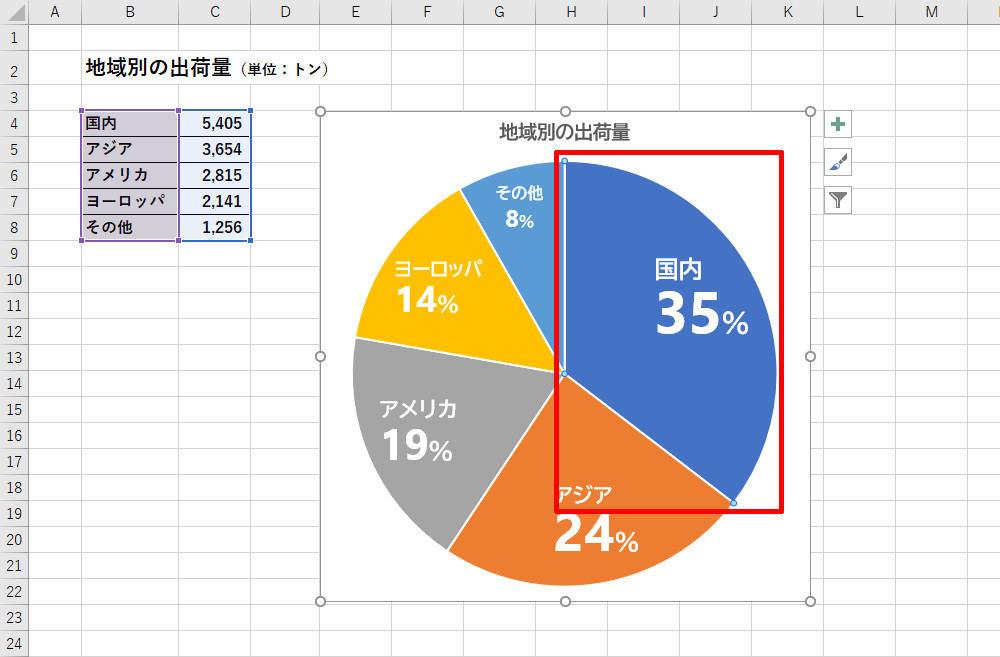Make your own color palette for graph design and use it
"How to specify a color?" Is a very big problem when designing a graph.However, it is surprisingly difficult to think about a good color scheme, and if you are thinking about color scheme each time, it will take time to create a graph.Therefore, let's introduce a method to prepare a color palette for creating a graph in advance and use it conveniently.
Graph color and design
There are two main types of graphs.The first is to convey the status and changes in numerical data in an easy -to -understand manner.The other is to use a graph like an eye catch as one point in the document.In the latter case, it is necessary to have some design on the graph.
So, this time, let's try to improve the efficiency of the work, especially for the graph design, especially the color scheme.First, the example of the graph used in this series is shown.The following figure is an example of when a "circular graph" is usually created.
As introduced in the 46th series, if you design the graph using the "text box", it will be as shown in the figure below.
This is not bad, but the impression of "I made it with Excel" remains.This is because the color scheme unique to Excel creates an atmosphere of a "common graph".
To improve this, you must customize the "graph color" and make it more original.The easiest way is to change the color scheme of the graph using the "Change Change" command.
As shown in the figure above, if you select a monochrome (monotone) color scheme, it can be improved to a sophisticated image graph.
In this way, the color of the graph has a great effect on the appearance impression.Although the color scheme can be easily changed with the "Change Change" command, there are only several patterns of color schemes here, and there are not many variations.Considering "dark → thin" and "thin → dark" as the same color scheme, only six types of monotone color schemes are prepared.
Use the Web to find your favorite color scheme
In order to create a graph with a variety of color schemes, you need to specify each color yourself.Nevertheless, it is surprisingly difficult to make it look good, and it will take a very long time.The color sense will also be questioned.
In such a case, you may want to use a website that introduces the "color scheme".If you search the web with keywords such as "color scheme", "color scheme", and "Color Pattern", you should be able to find such a website.
For example, "Schemecolor" introduced in the 15th series.By using "com" or "Palettable", you can easily find beautiful color schemes.
All you have to do is copy the HEX value of each color (6 digits of 6 digits starting with#) and use it to specify the color of the graph.This procedure is also explained in detail in the 15th series, so if you are not sure, you should refer to it.
In this series, I will introduce how to efficiently find the color scheme of monotone.When finding a monotone color scheme HEX value, it seems that the website called "HEX COLOR BLENDER" is convenient.
With this site, you can automatically create a "gradation color scheme" based on the two specified colors.First, specify the "first color".This color can be your favorite color.

Next, specify the "second color".You may specify the color such as "white" (#fffffff) or "black" (#000000).
Finally, specify the number of intermediate colors.For example, if the value of "5" is specified here, a total of seven gradation colors, "the first color" + "intermediate color 5" + "second color", can be created.
All you have to do is copy the HEX value displayed at the bottom and use it to specify the color.This allows you to specify the original monotone color scheme.
Creating a color palette for graphs
By using the website in this way, it is possible to create a graph with the original color scheme.Nevertheless, every time you create a graph, you can find a color scheme on the website each time, copy the HEX value, and so on.
Therefore, it is a good idea to prepare a "color palette" that collects your favorite colors.If you create a "color palette" in the following procedure, you will be able to create a graph immediately with the original color scheme without having to search for color schemes on the website.
Let's explain the procedure for creating a "color palette".First, open a new Excel book.When the new Excel book is displayed, click the "figure" on the "Insert" tab and select a "square" figure.
Next, drag the mouse and draw a "square" figure.At this time, dragging the mouse while pressing the "Alt" key can draw a figure along the "cell border".
Once you can draw a "square" figure, right -click the figure and select "Painted" → "Color of filling".
The "Color Settings" dialog is displayed. Select the "User Settings" tab and paste the HEX value copied from the website with the "Ctrl" + "V" key."A to F's capital letters / lowercase letters" and "#presence or absence" are automatically complemented, so you don't have to worry about it.
Click the "OK" button to see that the figure is filled with "color found on the website".Next, right -click the shape and right -click, and specify "Border" → "No border".
Now you can register the first color of the color scheme in the "Color Pallet".Next, let's create the second color.Drag the figure created earlier by pressing the "Alt" + "Ctrl" + "Shift" key and duplicated.By the way, each key plays the role of specifying the following movements.
"ALT" key: "Ctrl" key: "SHIRT" key to duplicate figures: Limit the movement direction to "horizontal" or "vertical".
If the "square" figure can be duplicated, specify "second color" with HEX value in the same procedure as before.
By repeating such operations and specifying your favorite color scheme as the color of "square", you can create a "color palette" as shown in the figure below.
All you have to do is save this Excel book in a file under name such as "Color Pallet".If you have time to spare, add the "favorite color scheme" you find to the color palette one after another, and you will gradually grow into a fulfilling color palette.
Color specification of graph using color palette
Finally, let's introduce how to customize the color of the graph using your own "color palette".First, click the "square" of the color you want to specify, select, and copy with the "Ctrl" + "C" key.
Open a graph created Excel file, "Slowly click twice" the figure that you want to specify the color, and select the figure individually.
If you press the "Ctrl" + "V" key in this state, the shape will be filled with the color you copied earlier.
By repeating the same work and pasting the color to each shape, a graph of the same color scheme as the "color palette" can be created.
As shown in the figure above, it will be useful to remember as an efficient work procedure that can handle colorful color schemes as well as monotone color scheme.The more your own "color palette", the more the color scheme will be enriched.
If the color of the graph (figure) is specified in this method, it will be treated as "painted (figure or texture)" instead of a normal "paint (single color)".There seems to be no major trouble, but you need to remember it just in case.

![[Latest in 2022] Explanation of how to register DAZN for docomo with images | 31 days 0 yen free trial reception until April 17](https://website-google-hk.oss-cn-hongkong.aliyuncs.com/drawing/article_results_9/2022/3/28/22149d541c51442b38a818ab134a8cf0_0.jpeg)
!["Amaho no Sakuna Hime" celebrates its first anniversary. The Ministry of Agriculture, Forestry and Fisheries moved to allow you to experience rice farming in a depth unparalleled in the history of games.A rice farming action RPG with over 1 million units shipped worldwide [What day is it today? ]](https://website-google-hk.oss-cn-hongkong.aliyuncs.com/drawing/article_results_9/2022/3/28/378f9ee978fe8784d8ab439d041eee85_0.jpeg)




